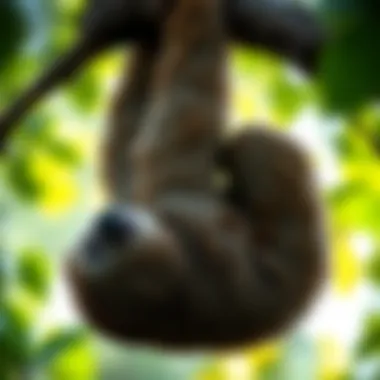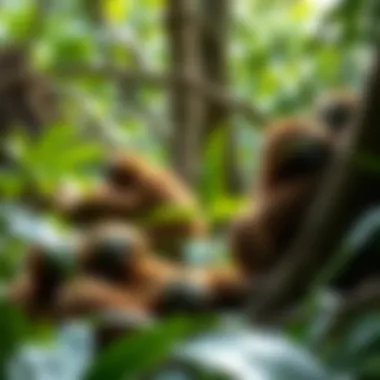The Adaptive Intelligence of Sloths: Learned Behaviors


Intro
When one thinks of sloths, images of languid movement and a sleepy demeanor often come to mind. Yet, there is more to these extraordinary creatures than their well-known laid-back lifestyle suggests. Sloths, often referred to as nature's own slowpokes, possess an intricate web of adaptations that not only define their survival strategies but also reveal their surprisingly complex intelligence. As we delve deeper into the world of sloths, we find that their unique behaviors, honed through experience, play a critical role in how they navigate their environment, hunt for food, and interact with other creatures.
In this article, we will explore various aspects of sloth behavior, such as their cognitive abilities and capacity for social learning. You'll learn how their environments shape their behavior, the implications of these adaptations for conservation efforts, and the evolutionary significance behind their seemingly lackadaisical pace.
Sloths have mastered the art of adaptability, crafting a niche that allows them to thrive in their natural habitats despite the threat of extinction from various environmental pressures. So, buckle up and prepare for a deep dive into the remarkable world of sloths—an expedition that is bound to challenge the preconceived notions about these remarkable creatures.
Preamble to Sloths and Their Unique Ecological Niche
Understanding sloths and their ecological role is crucial for grasping the intricate dynamics of tropical ecosystems. These creatures, often mistaken for mere leisure-seekers, play integral parts in maintaining their habitats, shaping both plant communities and broader environmental interactions.
Sloths are not just slow-moving mammals; they are unique organisms evolved to thrive in their specific environments. Their adaptations to a life suspended in the trees illustrate a fascinating intersection of evolution and habitat. By focusing on sloths, this article will explore how these creatures' behaviors—often written off as lethargy—actually highlight a sophisticated understanding of ecological balance.
Importance of Sloths in Ecosystems
- Nutrient Recycling: Sloths contribute significantly to nutrient cycling, particularly through their dung, which fertilizes vegetation, thereby promoting plant diversity.
- Habitat Creation: As they feed on tree leaves, sloths help maintain the health of their host trees, which in turn sustain various other species, creating rich biodiversity.
- Symbiotic Relationships: The fur of sloths hosts various organisms, including algae, which not only camouflage the sloths but also promotes a micro-ecosystem crucial for certain insects and microorganisms.
Writing about sloths assists in reorienting how we see not just these magnificent creatures but also the delicate webs of life they inhabit; it's an invitation to appreciate their world beyond surface levels. The subsequent sections will delve deeper into defining sloths and understanding their habitats, further illuminating the ecological significance of these remarkable animals.
Cognitive Abilities of Sloths
Understanding the cognitive abilities of sloths allows us to appreciate these unique creatures beyond their leisurely lifestyles. While one might think of sloths as slow and unresponsive, they possess intriguing intellectual traits that facilitate their survival. Cognitive abilities in sloths highlight the brain's adaptability to environmental challenges, which is crucial in a world that is rapidly changing. By examining these abilities, we not only gain insight into their behavior but also emphasize the role of intelligence in their daily lives—from foraging strategies to social interactions.
Brain Structure and Functionality
The brain of a sloth is as distinctive as its appearance. With a relatively small brain size compared to many mammals, sloths, however, demonstrate a notable degree of specialization. Studies have shown that the cerebral cortex, which is critical for processing information, is developed even in such a low-energy animal. This part of the brain is linked with higher cognitive functions and learning abilities.
Interestingly, sloths possess a unique neural architecture that caters to their lifestyle. For example:
- Sluggish Metabolism: The sloth's metabolism is among the slowest of all mammals, resulting in prolonged survival on a nutrient-poor diet. This trait is reflected in their cognitive strategy; they conserve energy by planning actions carefully and executing them slowly.
- Sensory Processing: Their visual cortex adapts to perceive movement carefully, allowing sloths to be vigilant of predators while they slowly traverse the tree canopy.
Overall, their brain's functionality underlines how they navigate their environment with reliance on learned experiences rather than rapid reactions. Such cognitive functionality is a testament to their adaptability, enabling them to thrive in their ecological niches despite their apparent lethargy.
Comparative Intelligence: Sloths versus Other Mammals
When we look at intelligence across the animal kingdom, sloths might not top the list alongside dolphins or chimpanzees. However, their intelligence is tailored to their specific needs. Sloths compare favorably with certain mammals when considering how their behaviors adaptively evolve.
- Diversity in Learning: Sloths may not be as socially complex as elephants or primates, but they exhibit unique forms of learning. Their capacity for habituation lets them adjust behaviors based on experiences, a trait seen in mammals like raccoons, who also learn from environmental cues.
- Energy Efficiency: While other mammals might boast agility and speed, sloths prioritize strategic energy use. Complete understanding of their surroundings allows them to find food sources without expending unnecessary energy.
Moreover, research suggests that sloths, like various marsupials, rely on visual learning to navigate their environment. They often observe other creatures to adapt their behaviors over time. This unique adaptation showcases a different approach to intelligence—one that values subtlety and efficiency over overt signs of agility or cleverness.
Sloths remind us that cognitive ability is not just about what is visibly apparent; it’s about how animals learn to thrive within their ecosystems, using the tools at their disposal, however limited they may appear.
Learning Mechanisms in Sloths


The exploration of learning mechanisms in sloths is pivotal for understanding the broader aspects of their survival and adaptability. These mechanisms reveal how sloths navigate their often harsh environments while utilizing their remarkable intelligence. Observing how sloths learn not only enriches our comprehension of these creatures but also sets the stage for conservation efforts aimed at preserving their habitats. The ability of sloths to adapt their behaviors based on experience highlights their resilience, an important trait in a world where environmental conditions are continually shifting.
Types of Learning Observed in Sloths
Habituation
Habituation is a fascinating learning process exhibited by sloths. This phenomenon involves an organism becoming accustomed to a specific stimulus after repeated exposure. For sloths, habituation is crucial as it helps them conserve energy and reduce stress. As they are often prey for larger animals, becoming desensitized to non-threatening elements within their environment allows them to focus on more pressing dangers. The key characteristic of habituation is its simplicity; it doesn't require complex cognitive processing, making it an accessible and efficient learning strategy. In the case of sloths, this can mean the difference between life and death when larger predators are lurking nearby.
Unlike more intricate learning forms, habituation offers a unique advantage: it allows sloths to exist with minimal energy expenditure while still being aware of potential threats. However, there are drawbacks; if a sloth becomes too complacent, it might overlook real dangers, thereby jeopardizing its survival.
Social Learning
Social learning is another important type of learning found in sloths. It refers to the process of acquiring new behaviors through observation of others. In sloth communities, younger sloths often learn vital foraging techniques and survival skills by watching their mothers or more experienced members of the group. The ability to imitate behaviors increases their chances of survival significantly. A noteworthy aspect of social learning in sloths is its slow-paced nature, matching their overall lifestyle. This gradual learning process is key to understanding how sloths maintain their ecological niche.
The benefits of social learning among sloths are considerable, enabling the younger generation to inherit important knowledge without risking their own safety through trial and error. Conversely, the disadvantage surrounding social learning stems from the reliance on social structures; if younger sloths aren’t exposed to knowledgeable adults, they may miss opportunities to learn essential skills.
Spatial Learning
Spatial learning encompasses the ability to understand and navigate their surroundings effectively. For sloths, this is essential given their treetop habitats. They develop a mental map of their territory, helping them identify the locations of food sources or safe nesting areas. The standout feature of spatial learning is its reliance on memory and cognitive mapping, which can greatly enhance a sloth's ability to forage efficiently.
Through spatial learning, sloths gain a competitive edge in their ecological niches by locating food sources quickly and efficiently. One major advantage is that this type of learning minimizes their energy expenditure by allowing them to navigate complex environments with ease. However, a disadvantage can arise when changes in their environment occur, forcing them to adapt their mental maps. In this regard, a sloth's survival can depend on its ability to quickly relearn its surroundings.
Impact of Environment on Learning
The environment plays a crucial role in the learning processes observed in sloths. Factors such as habitat quality, availability of food, and social structures all influence how sloths learn and adapt. For instance, in habitats where food is scarce, sloths may develop stronger spatial learning skills to locate hidden food resources. Similarly, in areas with more social interactions, one could observe an increased reliance on social learning mechanisms among sloth populations.
Additionally, environmental changes, such as deforestation or climate fluctuations, can hinder their ability to learn effectively. The stress caused by such changes might affect both memory retention and social dynamics, making it harder for sloths to pass on knowledge to younger generations. In the face of these challenges, understanding the adaptive intelligence of sloths through their learning mechanisms becomes crucial for devising effective conservation strategies.
Social Behavior and Interaction
Understanding the social dynamics of sloths is pivotal for grasping their overall adaptability. While many may view sloths as solitary creatures, the reality is rich and multifaceted. Their social behavior not only informs their survival strategies but also enhances their cognitive development through interactions within their communities. By examining sloth social structures and parental behaviors, we can unveil the intricate ways in which these animals thrive in their arboreal environments.
The Social Structure of Sloth Communities
Sloths exhibit a surprisingly complex social framework, often shaped by their need for safety and resource sharing. They tend to be more sociable than what first meets the eye, forming loose associations primarily for mating and sometimes during communal foraging setups, which is a savvy way of leveraging safety in numbers. The two-toed sloth is known to hang out in clusters, particularly in areas rich in food, which provides them a layer of security against their primary predators, like ocelots and eagles.
Interestingly, sloths communicate through a variety of vocalizations and body language, conveying messages that may range from mating calls to alerts about nearby threats. This ability to express themselves is crucial, considering the limited range of motion they possess compared to more agile animals. In essence, their social behavior isn’t just about interacting; it's also about ensuring that every member of the community contributes to the overall survival of the group.
"Sloths may appear to move at their own pace, but their social connections reveal a deeper complexity than often recognized."
Parental Care and Learning in Young Sloths
When it comes to nurturing their young, sloth mothers exhibit genuine investment and care. After giving birth, a mother sloth will nurse her baby for several months, teaching them essential survival skills along the way. The young ones cling to their mothers almost immediately after birth, a behavior that not only aids mobility but also fosters a close bond essential for learning. These infants are not just passive recipients of knowledge; they actively observe their mother’s foraging methods and social interactions.
This early education is critical. Young sloths learn what to eat, where to find food, and how to navigate their arboreal world. As they grow, they begin practicing these skills, often under the watchful eyes of their mothers. Learning during this formative period can significantly impact the infant's ability to survive in the wild once they are independent.


Moreover, the environment plays a critical role in shaping these educational experiences. When presented with challenges, such as limited food supply or increased predator presence, young sloths adapt their learning strategies. They become versatile and creative in their responses, reinforcing the idea that social structures and parental guidance intertwine with environmental factors to create a robust framework for learned behaviors.
Notable Learned Behaviors in Sloths
Understanding the learned behaviors in sloths sheds light on their adaptability and enhances our appreciation for their ecological role. Sloths are often mischaracterized as solely slow-moving creatures, yet their learned behaviors—rooted in cognitive abilities—substantially influence their survival. The insights gained regarding these behaviors not only deepen our comprehension of sloth ecology but also provide a greater understanding of the challenges they face in changing environments.
Foraging Techniques: Adaptations to Diet
Sloths possess a unique dietary preference that revolves primarily around leaves, which are relatively low in nutritional value. This limited diet necessitates a specialized approach to foraging, one that relies heavily on learned behaviors. Through experience, sloths have developed a repertoire of techniques that allows them to maximize their nutrient intake.
For instance, sloths have been observed to exhibit particular preferences for certain tree species. Their ability to recognize and remember the locations and characteristics of these trees is paramount for their foraging success. They learn which trees yield the most nutrient-rich foliage and also adapt their foraging strategies based on seasonal availability. Observations indicate that some sloths will even modify their climbing techniques based on the density and layout of branches, demonstrating a remarkable level of adaptability.
- Cognitive Mapping: Older sloths, especially, display an impressive ability to create cognitive maps of their foraging territories. Using cues from their environment—such as the sun's position or the smell of specific leaves—they navigate effectively, even in dense habitats.
- Trial and Error: Young sloths often experiment with various leaves, learning through trial and error which varieties yield the most satisfactory results in terms of taste and digestibility. This kind of learning is crucial, as it directly relates to their health and energy management.
The implications of these foraging adaptations extend beyond individual survival. As sloths engage in selective feeding behaviors, they also contribute to seed dispersal within their habitats, playing an integral part in plant regeneration processes.
Predation Avoidance Strategies
In a world where predators lurk, sloths must be shrewd to avoid becoming a meal. Their slow movements, which may seem like a disadvantage, actually play a significant role in their survival strategy. This is where learned behaviors come into play as young sloths observe their mothers and others in their community, acquiring vital knowledge about avoiding predation.
One striking behavior is known as “blending in.” Sloths possess a coat that can host green algae, which not only serves as camouflage against tree bark but also provides an additional layer of protection against predators like jaguars and harpy eagles. Over time, sloths learn the specific branches and foliage where they can remain concealed and what movements to avoid that might make them more visible.
- Heightened Awareness: Adult sloths teach their offspring to be wary of certain signals in their environment, such as the presence of predators or unusual sounds. This heightened awareness is cultivated through social learning, significantly affecting the survival rates of the young.
- Vigilance Without Stress: Interestingly, sloths exhibit a form of behavior known as “social vigilance.” They will often stay near friends or relatives when they feel threatened. This, they learn, not only aids in safety but also enhances their comfort and minimizes stress levels.
The nexus of learned behaviors regarding predation avoidance is not just a matter of individual survival. They are critical for the stability of their population and contribute to the overall dynamics within their ecosystem.
Through these learned behaviors, sloths demonstrate a complexity that defies their reputation as lazy creatures, showcasing a level of adaptability that is indeed remarkable.
In summary, the behaviors illustrated here are more than mere traits. They are essential components of sloth life, illustrating the delicate balance of their interaction with the environment. Understanding these behaviors provides key insights into conservation strategies and highlights the necessity of preserving their natural habitats amid the growing pressures of climate change.
Implications for Conservation
The ability of sloths to adapt and learn is not just a mere interesting fact; it serves as a backbone for understanding their survival in increasingly changing environments. With deforestation and climate change playing heavy roles in shaping their habitats, understanding sloth behaviors becomes critical for their conservation. Behavioral adaptation can mean the difference between thriving or dwindling populations.
Among the various implications for conservation, the most important aspects include recognizing the connection between learned behaviors and survival, assessing how these behaviors can influence management practices, and considering the long-term sustainability of sloth populations in fragmented habitats. Understanding how sloths respond to changes in their ecological niche helps in formulating policies that prioritize habitat protection and restoration.
"Every limited habitat poses unique challenges; it opens a Pandora’s box of adaptation potential that we must study and embrace in conservation efforts."
The Importance of Behavioral Adaptation in Changing Environments
As climates shift and habitats deteriorate, sloths are faced not only with physical changes but also with new challenges that require behavioral adaptations. For example, the availability of food sources can vary dramatically due to environmental changes. Sloths, known for their specialized diets, may need to develop new foraging techniques or shift their eating habits if their preferred leaves become scarce.
This capacity to learn and adapt is fundamentally tied to their survival. When sloths are able to modify their behaviors—be it in finding food, avoiding predators, or establishing social bonds—they increase their chances of sustaining their populations amid these pressures. Observations indicate that sloths might learn from one another about new food sources or safe routes via social learning, something vital for their survival. Therefore, understanding their learning mechanisms gives conservationists a clearer picture of what these animals need in order to thrive in an uncertain future.
Conservation Strategies Focusing on Behavior


Conservation strategies must keep pace with the unique behavioral traits exhibited by sloths. Emphasizing behavior-centric conservation can lead to more nuanced and effective approaches. For instance, creating protected corridors that facilitate movement between fragmented habitats allows sloths to explore, find new food sources, and engage in social interactions that can promote their learning.
Moreover, community engagement is key. Local populations can be educated about the importance of sloths and the role their behaviors play in the ecosystem. Incorporating traditional knowledge and practices that respect terrestrial wildlife can create a synergy benefiting both sloths and the human communities living nearby.
In summary, conservation that centers on the adaptive intelligence of sloths can enhance efforts to ensure their survival. This focus isn’t just valuable; it is necessary to navigate through the complexities of preserving such unique creatures in a rapidly evolving world.
Future Directions in Sloth Research
The study of sloths, often viewed through a lens of lethargy and passivity, is evolving rapidly, revealing more about their complex behaviors and critical roles in ecosystems. When it comes to future research avenues, it’s essential to understand how these aspects can shape conservation efforts and provide insights that go beyond mere observation.
Researchers are beginning to emphasize the adaptive intelligence of sloths and how their learned behaviors might inform both ecological balance and conservation methodologies. By delving into these uncharted territories, scientists can not only uncover new answers but also enhance awareness of sloths' ecological importance.
Technological Advances in Animal Behavior Studies
The advent of new technologies is paving the way for deeper explorations into sloth behaviors. Innovations in remote sensing and tracking are particularly noteworthy. For instance, GPS collars are now enabling scientists to monitor sloth movements and activities with remarkable precision. This tech can record data on their feeding habits and interactions with other wildlife, offering insights previously unattainable through traditional methods.
Consider the use of drone footage to study their habitats. High-resolution images obtained from drones provide observers with a birds-eye view of sloth communities in their natural surroundings. These visuals can reveal patterns of behavior related to foraging strategies and social interactions that researchers may have missed from the ground. Moreover, tools like accelerometers and bio-loggers allow scientists to gather data on sloths' physical activities continuously.
Thus, understanding sloth activity levels in context to their environments becomes significantly clearer. These technological advances hold promise for enriching existing knowledge and guiding future conservation strategies.
Potential Areas of Exploration and Discovery
There's a treasure trove of potential research avenues when it comes to sloths that remains largely untapped. Here are several promising areas that could likely contribute significantly to both the scientific community and conservation efforts:
- Behavioral Ecology: Further studying how sloths adapt to changing environments can clarify their survival strategies against climate change and habitat destruction.
- Neuroscience Investigations: Understanding the neurological underpinnings of sloth behaviors could unveil how these animals process their surroundings, learn, and adapt.
- Impact of Urbanization: Investigating how urban encroachment affects sloth populations and their behavioral adaptations is crucial as human habitats expand into natural areas.
- Comparative Studies: Analyzing sloths alongside similar species could yield insights into evolutionary adaptations and survival methods among different mammals.
- Genetic Studies: Exploring the genetic basis for their unique adaptive behaviors might provide clues about their resilience in the face of environmental pressures.
By addressing these areas, researchers can better understand the intricate web of interactions that define sloths in their ecosystems. The continuity of this research not only benefits sloths but also the broader ecosystems that hinge upon their health and behavior.
The adaptive intelligence of sloths offers a window into ecological resilience, inviting us to rethink the way we view these creatures in the wild.
Through the development of these knowledge realms, the future of sloth research stands at an exciting threshold. It’s an opportunity to reshape conservation strategies, ensuring these fascinating mammals not only survive but thrive within their natural habitats.
Ending: The Complexity of Sloth Behavior
In looking back on the fascinating exploration of sloth behavior, it's clear that these creatures are more than just the slow-moving denizens of the treetops. Understanding their actions, thought processes, and learned adaptations sheds light on their survival strategies and their relationship with the intricate ecosystems they inhabit. Delving into sloth learning and cognitive abilities reveals the complex interplay that defines their lives.
Summarizing the Insights on Sloth Learning
The insights gained from studying sloth learning are numerous and impactful. Sloths showcase a variety of learning mechanisms that help them navigate their challenging habitat. For instance, they exhibit habituation, allowing them to become accustomed to threats or disturbances in their environment. This gradual desensitization is crucial for their survival, as it enables sloths to conserve energy, avoiding unnecessary stress and potential danger.
Additionally, social learning has been observed among young sloths who tend to mimic adult behaviors. This learning style underscores how knowledge is passed down through generations, assisting young ones in mastering skills such as foraging and predator evasion without trial and error each time.
Another vital aspect is spatial learning, where sloths have shown the ability to remember locations of food sources. Their keen memory plays a crucial role in their ability to thrive in areas where food might be sparse. All of these learned behaviors not only affirm that sloths are intelligent but also reflect their capacity to adapt to environmental changes.
Reflecting on the Importance of Understanding Animal Behavior
Understanding animal behavior, particularly in species as unique as sloths, has far-reaching implications for wildlife conservation efforts and can transform how we perceive these animals. An in-depth comprehension of sloth behaviors encourages a shift in perspective, moving away from the stereotype of sloths as sluggish and lazy, towards recognizing them as creatures that are finely tuned to their environment.
By uncovering the complexity of sloth behavior, researchers can develop targeted conservation strategies. This approach is becoming increasingly vital as sloth populations face threats from habitat destruction and climate change. For instance, knowledge about their foraging habits can inform how habitats should be preserved or restored to ensure they can find food easily amid environmental shifts.
Moreover, educating the public about sloth intelligence fosters a greater appreciation for them, leading to increased support for conservation initiatives. When people understand that sloths have intricate social structures and learned behaviors, it builds a narrative that their preservation is not just about saving a species, but also about maintaining a richer, more biodiverse world.
"Understanding the behaviors and intelligence of sloths deepens our connection to nature and emphasizes our responsibility in their conservation."







